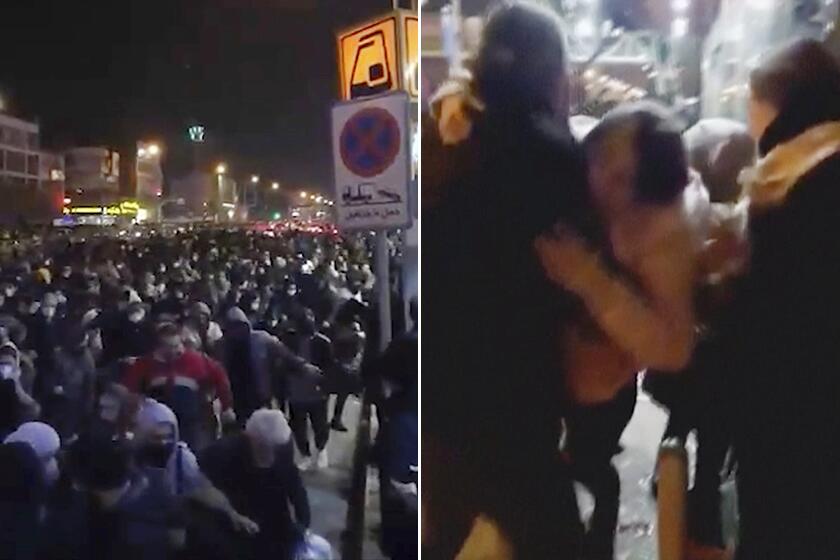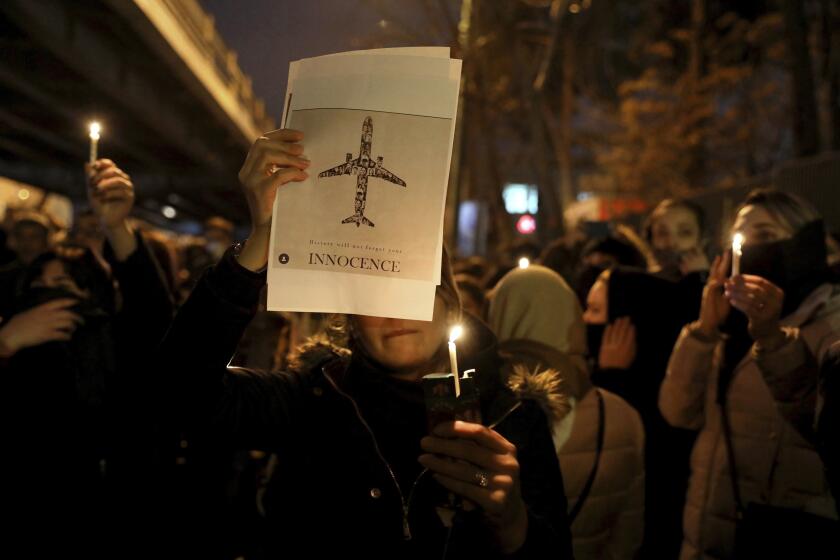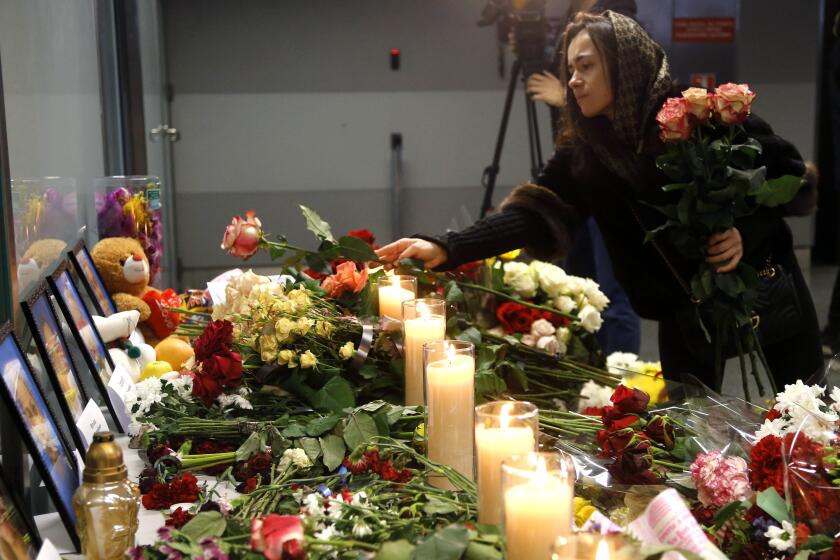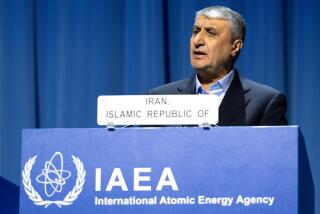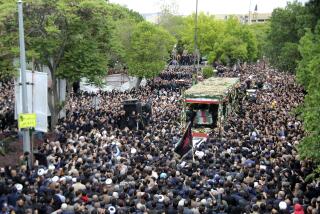For decades Iranians have risen up, only to be put down

- Share via
DUBAI, United Arab Emirates — The demonstrations that erupted after Iran admitted to accidentally shooting down a passenger plane during a tense standoff with the United States last week are the latest of several waves of protest going back to the 1979 Islamic Revolution — all of which have been violently suppressed.
Iranians were shocked and appalled by the shoot-down of the Ukrainian jetliner which killed all 176 people on board, mostly Iranians. Many are also angry at the government’s misleading statements in the wake of the tragedy, which it initially blamed on a technical problem.
Iranians are also suffering from an economic crisis exacerbated by severe sanctions imposed by President Trump after he withdrew the U.S. from Iran’s 2015 nuclear deal with world powers.
Trump has encouraged the protests — even as he has long embraced other autocrats who smother dissent. His administration hopes that the demonstrations, along with crippling U.S. sanctions, will bring about fundamental change in a longtime adversary.
But large numbers of Iranians still support the clerically led government, as seen by the massive turnout for the funeral of Gen. Qassem Suleimani, Iran’s top general, who was killed in a U.S. airstrike in Baghdad. Even many critics of the government saw him as a war hero who had helped defeat Islamic State and resisted Western hegemony in the Middle East.
Videos purport to show Iranian police firing tear gas and live rounds at those protesting Iran’s initial denial that it shot down a Ukrainian jetliner.
Iran’s security forces have shown in the past that they will use deadly force against anyone threatening the Islamic Republic, most recently in November, when rights groups say hundreds of people were killed in demonstrations sparked by a hike in gasoline prices.
Here is a look at past protests in Iran, and how its theocracy prevailed.
The Islamic Revolution
The 1979 Islamic Revolution began with broad-based mass protests that eventually forced the Western-backed monarchy from power. But in the resulting chaos, hard-line followers of Ayatollah Ruhollah Khomeini quickly moved to sideline left-wing and moderate opposition groups, forcing many Iranians into prison or exile and establishing a firm foundation for clerical rule. Iran also suppressed a rebellion from among its Kurdish minority in a yearslong military campaign. In 1988, at the close of the disastrous Iran-Iraq war, Iran is believed to have executed thousands of political prisoners, something authorities have yet to publicly acknowledge.
A student uprising
The closure of a reformist newspaper in 1999 ignited a week of student protests. On July 9, security forces and hard-line vigilantes stormed a student dormitory at Tehran University. At least three people were killed and 1,200 were arrested in the unrest, which spread to other cities. The protests unfolded amid a power struggle between President Mohammad Khatami, a popular reformist, and hard-liners who dominate the Revolutionary Guard and the security apparatus. The hard-liners eventually prevailed, and the resulting crackdown set back reform efforts for a decade.
Despite Trump’s claim that slain Iranian general had been planning attacks on four U.S. embassies, senior administration officials cite no specific intelligence. In Iran, anti-government demonstrations spread to several cities.
The green movement
The largest and most sustained protests since the Islamic Revolution erupted in the summer of 2009, after the reformist opposition disputed the reelection of hard-line President Mahmoud Ahmadinejad. Millions of Iranians took part in months of protests in several major cities. Green movement leaders did not call for the overthrow of the system, but for the reversal of the allegedly rigged election, greater social freedoms and the reining in of the security forces.
Authorities nevertheless responded with a massive crackdown. The Revolutionary Guard and its volunteer force, the Basij militia, opened fire on protesters and launched a wave of arrests. Opposition leaders were placed under house arrest and silenced in the largely state-run media.
President Obama came under criticism for not offering a full-throated endorsement of the protests. But it’s unclear if that would have made a difference, and it might have fed into hard-liners’ allegations that the protests were part of a Western plot.
“We expect Iran to pledge readiness to carry out a full and open investigation,” Ukraine President Volodymyr Zelensky says of airliner shootdown.
Economic protests
Since withdrawing from the 2015 nuclear agreement between Iran and world powers, Trump has imposed “maximum” sanctions on Iran that he says are aimed at countering its nuclear program and its support for armed groups across the region. The sanctions, including those targeting the vital oil industry, have eviscerated Iran’s economy, wiping away many people’s life savings and fueling high unemployment.
In the 18 months since the U.S. began restoring sanctions, Iran has seen waves of sporadic, leaderless protests initially focused on economic grievances and perceived corruption among the clerical elite and the Revolutionary Guard. Each time, the protests rapidly escalated into chants against Supreme Leader Ayatollah Ali Khamenei and calls for the end of clerical rule.
The protests have often turned violent and security forces have responded with deadly force. In the most recent and deadly wave of protests, in November, authorities shut down access to the internet for several days, making it difficult to discern the scale of the protests and the resulting crackdown.
Amnesty International estimates that more than 300 people were killed.
More to Read
Sign up for Essential California
The most important California stories and recommendations in your inbox every morning.
You may occasionally receive promotional content from the Los Angeles Times.
